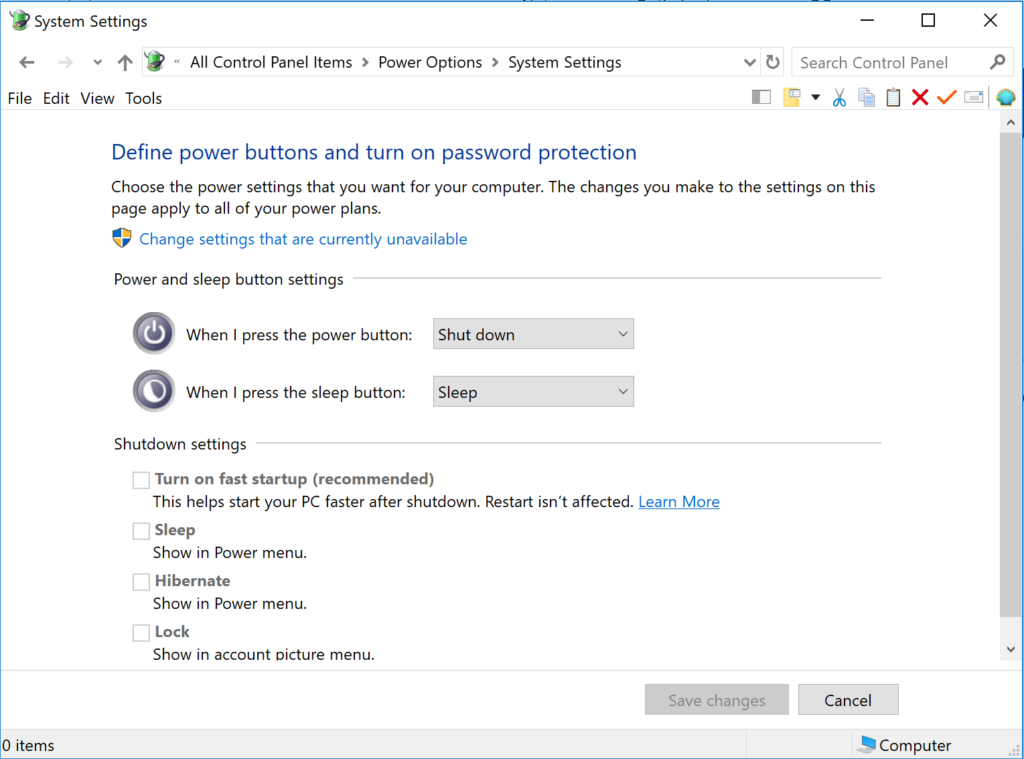FASTER STARTUP – FASTER BOOT THROUGH POWER SETTINGS
Windows has a fairly well hidden option to allow you to have a quicker startup…even with SSDs. Faster Startup can be found by following Start Orc/Control Panel/Power options/Choose What the Power Buttons Do/Click on ‘Change Settings that are currently Unavailable’/ Check ‘Turn on Fast Startup’ and ‘Save Changes.
NOTE!!! This option will only be visible and can only be applied if Hibernation has NOT been turned off.
There is a bit of a hiccup that may eventually occur with this tip. If you experience very long shutdown times, or even your system failing to shut down completely, the general rule is to uncheck ‘Turn on Fast Startup’. This has occurred to me and I found this solution to work after finding it on the internet.
FASTER STARTUP – FASTER BOOT THROUGH MSCONFIG
This selection disables the GUI start screen on boot, saving a few seconds during the boot process. Click the Windows key and ‘R’, and then type MSConfig. From there, select Boot, check ‘No GUI Boot’ and save.
FASTER STARTUP – TURN OFF MULTI BOOT SELECTION
This optimization should be followed if more than one drive is used to boot separate systems in the same computer. For Windows 8 users, type ‘Computer’ on the Start Screen and right click on the icon. Select ‘Properties’, ‘Advanced System Settings’, ‘StartUp and Recovery’, and then uncheck the Time to Display List of Operating Systems before clicking ‘OK’.
SUPERFETCH, PREFETCH, SEARCHAND INDEXING
We had covered Superfetch and Prefetch in our previous SSD Optimization Guide and disabling these doesn’t occur ever in our system builds anymore, as these are disabled automatically and only accounted for SSD endurance, something that we also don’t concern ourselves further. Unlike hard drives, most SSDs will last much longer than the system they are installed in.
Searching and Indexing were also endurance optimizations but we have changed our opinions of these after discovering a very annoying occurrence with Windows 10. When Search and Indexing are disabled and you are looking through a folder of pictures, many times you will not have the left or right arrow in the picture to move to the next shot. This alone was enough to change our decision on this optimization as we work with pictures quite often.
MANUFACTURERS SOFTWARE
Most manufacturers have software ‘toolboxes’ that assist in monitoring and keeping your SSD in top shape, along with enabling things such as firmware updates, secure erase, over-provisioning, confirming TRIM works and even their own performance benchmark. This is the Samsung Magician report of our newest 960 Pro 2TB NVMe SSD and we were surprised to learn that the firmware was outdated, especially since Samsung had just sent us this SSD last week.
In updating our firmware, we didn’t see any performance improvement but we thought we might pull off a manufacturers benchmark. Oh yuk…time to figure this one out:
So let’s see it with Write-Cache Buffer Flushing unchecked…..
And this is what can be really frustrating about wanting the absolute peak performance… Just when you think you have something set, a change occurs that blows away your theory. Will need to follow this up with a complete test regimen.
 The SSD Review The Worlds Dedicated SSD Education and Review Resource |
The SSD Review The Worlds Dedicated SSD Education and Review Resource | 

